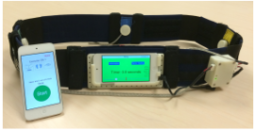Automated, Data-Driven, and Personalized Home-Based Balance Trainer
TECHNOLOGY NUMBER: 2021-336
Tags:

OVERVIEW
Automated and personalized at-home balance therapy- Maps body-kinematic data to functional performance
- Allows a more precise and individualized progression of balance exercise
BACKGROUND
Age-related declines in balance can be caused by loss of muscle strength and joint flexibility, reduced vision and reaction time, inner ear dysfunction, or nervous system miscommunication. Falls are the leading cause of fatal and non-fatal injuries among adults 65 years of age and older, so the prevalence of this problem is predicted to increase dramatically along with the aging of populations in developed countries. Fall prevention programs include balance exercise regimes to facilitate functional mobility. Although effective, balance-training programs require frequent visits to the clinic and the supervision of a physical therapist, prohibiting access for many older adults. Furthermore, at-home therapy is often ineffective due to a lack of professional feedback, fear of performing exercises incorrectly, and loss of motivation due to limited results. Current methods for evaluating balance often rely on potentially subjective visual assessments from therapists, or self-assessments that do not always accurately correspond to actual performance. A need exists for a more effective at-home balance training program that incorporates professional guidance and successful results.
INNOVATION
Researchers at the University of Michigan have developed a home-based smartphone balance trainer that utilizes a machine learning platform to characterize mapping from body-kinematic data to functional performance. The device is comprised of two smartphones, one used for sensing movement and another capable of serving as the user interface to custom software. The device is portable and capable of providing real-time vibrotactile cues for informing balance corrections. Patient movements are automatically modeled for balance issues, after which the device delivers person-specific training guidance. This technology also generates a progression scheme of balancing exercises based on a data-driven personalized recommender system.The balance instruction provided is based upon the process used to evaluate and progress patients through in-person therapeutic and preventive balance training programs devised by experts. The device can be used to both complement and supplement existing clinic-based balance training programs. It is designed for use in both clinical settings and in the homes of community dwelling older adults. This invention will transform balance-training therapy from clinic-centered, labor intensive to home-based, personalized, and data-driven results.
-
expand_more mode_edit Inventor (10)Christopher DiCesareFahad KamranJamie FerrisJenna WiensJeremiah HauthKathleen SienkoSafa JabriTian BaoWendy CarenderXun Huan
-
expand_more cloud_download Supporting documents (1)Product brochureAutomated, Data-Driven, and Personalized Home-Based Balance Trainer.pdf